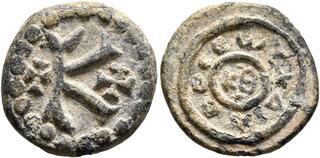Lot description:
Justinian I (?), 527-565. Half Follis (Lead, 18 mm, 4.18 g, 1 h), RY 29 = 555/6 (?). Large K between two crosses; all within border of large pellets. Rev. +ΔIAΔOCЄⲰC ('distribution') around central KΘ with horizontal line above within circle. Apparently unpublished. An excellent and well-struck example. Very fine.
From a European collection, formed before 2005.
This piece is part of an intriguing series of early Byzantine lead coins that is apparently unpublished, apart from a pentanummium in Dumbarton Oaks (BZC.2006.4). All obverses have a large numeral as the main device, corresponding to the Byzantine system of denominations that was in place since the sixth century. We find a pentanummium, a decanummium, a half follis, as well as a follis (not represented in this sale, but recently sold by Sol E-Auction 23 (2023), 982). There is also a trinummium, a denomination that was only struck in bronze in Thessalonica during the reign Justin I and in Alexandria during the reigns of Justinian I and Heraclius. Interestingly, a lead trinummium that was apparently struck in the region of Antioch under Justinian I was published by Wolfram Weiser (W. Weiser: Neue byzantinische Kleinmünzen aus Blei, in: Schweizer Münzblätter 137 (1985), p. 13-16. An additional example appeared in Stack's, The Golden Horn Collection (2009), 3061).
The reverses of the series all have a large KΘ as the main device, often with the Greek circular legend 'diadoseos' around. This word identifies the series as part of a 'distribution' and implies that these pieces were to be redeemed for something else – perhaps a sum of money paid out in official coins, or gifts in kind corresponding to the numerals. In any case, it sets them apart from other known lead coins, which are viewed as 'official', state-sanctioned emergency coinages. Apart from the aforementioned publication by Weiser, an important corpus of these lead coins was published by Cécile Morrison (C. Morrison: Monnaies en plomb Byzantines de la fin du VIe et du début du VIIe siècle", in: Rivista italiana di numismatica e scienze affini 83 (1981), p. 119-131). All published pieces are fractional folles and typically have the imperial portrait on the obverse and the denomination on the reverse. They were usually attributed to the reigns of Justin II up to Constans II, but very few have enough distinctive features to allow a precise identification or date. Lastly, Michael Mitchiner published another group of these lead coins, including a series that corresponds to the Alexandrian denominational system and may be attributed to Constans II (M. Mitchiner: The aftermath of the Arab conquest of Egypt and Syria: Two small series of Byzantine-style lead coins, in: Journal of the Oriental Numismatic Society 225 (2015), p. 19-22.)
The dating of the KΘ-series must remain tentative, but it is attributed here to the reign of Justinian I for several reasons. First, the existence of parallel trinummium pieces in bronze and lead directs us to the reigns of Justin I and Justinian I and to Antioch. Second, the distinctive design of the pentanummium type with a large epsilon ligated with a central cross is typical of Antioch during the reign of Justinian I (SB 241-244). And finally, an attribution of the series to the reign of Justinian I would allow for the interpretation of KΘ on the reverse as regnal year 29. With few Byzantine emperors ruling this long, this renders Justinian I an obvious candidate. If this interpretation is correct, then the circumstances for the distribution alluded to on the reverse legend may have been the aftermath of the western campaigns against the Goths in Italy.
Starting price: 25 CHF |  |